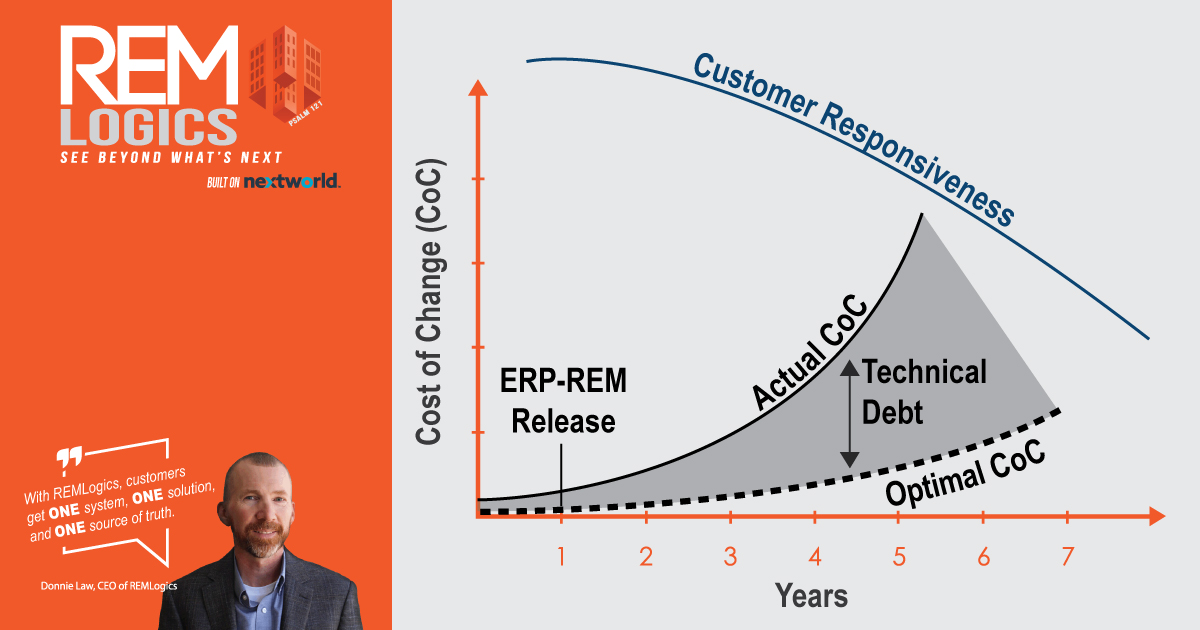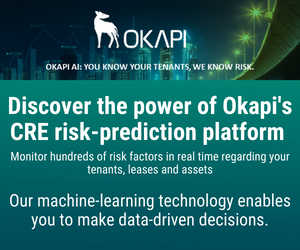Assessing the Technical Debt of Legacy ERP Real Estate Management Systems
Konrad Rogers, COO, Nextworld

Technical debt is a measure of a company’s burden that stems from aging and inflexible computer systems and can be just as much of a liability as financial debt - yet it never shows up on quarterly reports.
In one McKinsey survey, 87% of global CIOs said the complexity of their existing systems prevents them from investing in the next generation of services.
We see a technology revolution today that is different from past platform shifts. The best cloud software today is designed with a humility that accepts no single solution can do everything. Rather, it’s built to work with multiple programs while keeping a single up-to-date version of critical data. It empowers rather than inhibits innovation by business units.
The best way to incorporate this powerful new architecture is to start with a clear-eyed assessment of an organization’s technical debt.
Many companies will come out of this assessment concluding that most of their technical debt can be traced to one system: their enterprise resource planning (ERP) and real estate management (REM) software. There is a way you can turn your ERP-REM system from your company’s biggest source of technical debt into a tool that can retire most of it.
The causes of technical debt
There is no escaping technical debt.
A rush to get something to market, satisfying a C-suite directive, or a host of other issues can sidetrack any thought of a strategic IT investment. It simply seems smarter to pick the fastest solution, not the one that preserves long-term resilience, thus increasing technical debt.
Desperate to compete with more nimble rivals, business-unit leaders invest in shadow IT initiatives, surreptitiously deploying technology - often cloud-based services - outside of the central technology organization.
Shadow IT investments, no matter how well intentioned, exponentially increase the complexity of the overall organization’s technological infrastructure, fragmenting its data, and making future upgrades even more expensive. Technical debt spirals upwards.
The catalyst for technical debt
Nothing has contributed more to technical debt than legacy ERP Real Estate Management systems. Software vendors promised a unified view of everything in a company - people, leases, properties, finance, lease accounting, billing, revenue (the “enterprise resources” part) - so its leaders could make better decisions (the “planning” part).
These systems delivered the promised benefits of centralized data, but at quite a cost: installation and maintenance were expensive, time-consuming, and painful.
Many companies find that the technology meant to be the center of their operations and the custodian of their most important data is in fact the least flexible and reliable component of their IT infrastructure. These flaws ripple through every other system in the enterprise and encourage the deployment of marginally compatible bolt-on services by IT and business units acting on their own.
Measuring the cost of technical debt
Let’s look at a simple way to assess the annual cost of maintaining a legacy system. Go over your company’s overall IT spending to get a ballpark number. More important, this is a method that you can apply consistently to manage and reduce your technical debt over time.
Then, get your CIO and CFO together to evaluate technology spending company-wide by central IT and/or separate business units. Add everything that isn’t the cost of building new capabilities - the cost of keeping the machines on. This number will never be zero, but not too high to crowd out progress.
Expenditures include resources devoted to:
- Operating and maintaining the existing ERP-REM functionality.
- New development projects.
- User support and bug fixes.
- Software maintenance and routine upgrades.
- Systems to move data between other systems.
Calculate the sum of these costs as a percentage of your company’s overall IT spend.
A standard goal should be to spend less than half your technology budget on doing the same thing today as yesterday. It’s a goal most companies can’t meet. A survey of CIOs by Deloitte reveals the average company only spends 19% of its technology budget on innovation.
Those companies Deloitte categorizes as “digital vanguards,” allocate a slightly better 26% of their budgets on innovation and have set ambitious targets to raise that number to 33% in the next 3-5 years.
How to get out of technical debt
Assess your company’s current spending in service of its technical debt by reviewing your historical financial statements and budgeting process to see if things are getting better or worse.
Here are indicators that can increase technical debt:
- A backlog of project requests from business units - an open invitation for operating departments to go rogue with shadow IT.
- Contractors and consultants hired to fix or maintain existing systems - regularly calling in reinforcements to put out fires.
- A rise in support cases about core functionality that is impaired - complaints that data is missing or out of date, or that existing features have stopped working.
- IT decides not to upgrade software the company continues to use - a strong signal the company’s systems are a house of cards.
- Multiple contracts for the same software or several applications with duplicate functions - a sign IT is so dragged down by technical debt that business units are breaking loose.
In another survey by McKinsey, three out of five CIOs said their company’s technical debt had increased over the past three years.
Global CIOs are as gloomy here as they’ve been in the other surveys quoted. They tell McKinsey that their total technical debt is between 20% and 40% of the total value of their “technology estate” before depreciation. Translation: more money than anyone wants to spend.
The disruptive nature of latest technologies is designed to mitigate the major causes of technical debt. Cloud services reduce the pain of upgrades. APIs enable data to be validated and exchanged in real-time. No-code tools enable business units to develop and customize their own applications that don’t disrupt the business when the next release from the software vendor arrives.
Well-designed, cloud-native software understands it’s not going to be the solution for everything. Accordingly, it’s built to integrate seamlessly with other strategic real estate applications.
As you make tactical decisions about maintaining and expanding your systems, look for solutions that incrementally mitigate rather than exacerbate your technical debt. Choosing cloud-native solutions designed for integration increases speed, data accuracy, and flexibility.
How cloud ERP Real Estate Management wipes out technical debt
Resist the temptation to wave the banner of digital transformation while bolting fancy applications to a back end that can’t support them.
The most powerful way to reduce technical debt is to eliminate its primary cause: your legacy ERP-REM system - the most brittle component of your infrastructure and the primary driver of your overlapping applications.
Switching to the right cloud-native ERP Real Estate Management system can radically reduce the complexity of your organization’s technology infrastructure. It can handle many functions that had been relegated to bolt-on applications. It will provide a no-code development environment to allow customization and new applications. And it will exchange data easily and accurately with the other systems your company continues to use.
Once you switch, your technical debt falls sharply and will stay significantly lower than the status quo - freeing up the resources to innovate and use modern technology to drive your business forward.
This Week’s Sponsor
We help customers See Beyond What’s Next with cloud-native ERP real estate management solutions for office, retail, industrial, and residential owner operators. REMLogics is built on a modern no-code ERP platform so customers can continually innovate and respond faster to the ever-changing real estate and technology landscape. To learn more visit www.remlogics.net.
Read Next
 3/27/2025
3/27/2025
The Convergence of Edge Computing, Cloud, and AI in Building Automation and Smart Buildings In the built environment, we have seen the convergence of Operational Technology (OT) and Information Technology (IT), later expanding to include Workplace Technologies (WP).
 3/27/2025
3/27/2025
DC Power: A Holistic Approach to Energy Savings in Commercial Buildings In today's energy-conscious world, businesses constantly seek ways to reduce their carbon footprint and operational costs.
 3/13/2025
3/13/2025
How to Achieve Eco-Friendly Facility Management Commercial real estate operators and facility managers are focusing on sustainable practices to minimize environmental impact, create healthier workplaces, improve productivity and lower operational costs.
 1/23/2025
1/23/2025
When It Comes To Managing Properties’ Parking, Technology Is Key It’s easy for developers and real estate owners to think of parking as a necessary evil. They know they have to provide it (often, because it’s mandated by code), they understand that prospective tenants and buyers expect to be provided parking, but they haven’t figured out how to maximize its value.







.gif)





